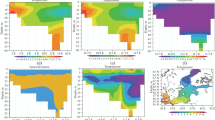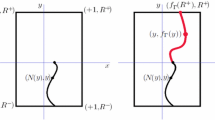Abstract
The inverse problem of recovering boundary functions on external and internal open boundaries for an open sea hydrodynamic model based on the linearized shallow water equations is considered. The external open boundary is meant as the boundary separating the considered water area from the world ocean. The internal open boundary is introduced to use the domain decomposition method. The inverse problem is studied theoretically, including the proof of its unique and dense solvability. An iterative algorithm for its solution is formulated, which combines variational data assimilation with the domain decomposition method. The theoretical study is illustrated by numerical results obtained for a test problem.






Similar content being viewed by others
REFERENCES
M. A. Spall and W. R. Holland, “A nested primitive equation model for oceanic applications,” J. Phys. Oceanogr. 21 (2), 205–220 (1991).
A. I. Kubryakov, “Application of nested grids in a system of monitoring hydrophysical fields in Black Sea offshore regions,” Ecological Safety of Offshore and Shelf Regions and Complex Use of Shelf Resources (NPTs “EKOSI-Gidrofizika,” Sevastopol, 2004), Vol. 11, pp. 31–50.
P. Marchesiello, J. C. McWilliams, and A. Shchepetkin, “Open boundary conditions for long-term integration of regional oceanic models,” Ocean Model. 3, 1–20 (2001).
I. A. Chernov and A. V. Tolstikov, “Numerical simulation of White Sea large-scale dynamics,” Trudy Karel. Nauchn. Tsentra Ross. Akad. Nauk 4, 137–142 (2014).
S. A. Myslenkov, “Satellite altimetry data application for the calculation of the water transport in North Atlantic,” Proc. Hydrometcenter Russ. 345, 135–143 (2011).
C. A. Edwards, A. M. Moore, I. Hoteit, and B. D. Cornuelle, “Regional ocean data assimilation,” Annu. Rev. Mar. Sci. 7, 6.1–6.22 (2015).
E. Audusse, P. Dreyfuss, and B. Merlet, “Optimized Schwarz waveform relaxation for primitive equations of the ocean,” SIAM J. Sci. Comput. 32 (5), 2908–2936 (2010).
H. S. Tang, K. Qu, and X. G. Wu, “An overset grid method for integration of fully 3D fluid dynamics and geophysics fluid dynamics models to simulate multiphysics coastal ocean flows,” J. Comput. Phys. 273, 548–571 (2014).
M. P. Daou, E. Blayo, A. Rousseau, O. Bertrand, M. T. Pigeonnat, C. Coulet, and N. Goutal, “Coupling 3D Navier–Stokes and 1D shallow water models,” Simhydro 2014: Hydraulic Modeling and Uncertainty, June 12–13, 2014, Sophia Antipolis, France, 2014. https://hal.inria.fr/hal-00995171/document. Accessed June 1, 2019.
E. Blayo, A. Rousseau, and M. Tayachi, “Boundary conditions and Schwarz waveform relaxation method for linear viscous shallow water equations in hydrodynamics,” SIAM J. Comput. Math. 3, 117–137 (2017).
L. D’Amore, R. Arcucci, L. Carracciuolo, and A. Murli, “DD-OceanVar: A domain decomposition fully parallel data assimilation software for the Mediterranean forecasting system,” Procedia Comput. Sci. 18, 1235–1244 (2013).
T. O. Sheloput and N. R. Lezina, “Joint implementation of data assimilation on 'liquid' boundaries and domain decomposition in the Baltic Sea,” Vestn. Tver. Gos. Univ., Ser. Geogr. Geoekol., No. 3, 168–179 (2018).
A. Teruzzi, P. Di Cerbo, G. Cossarini, E. Pascolo, and S. Salon, “Parallel implementation of a data assimilation scheme for operational oceanography: The case of the MedBFM model system,” Comput. Geosci. 124, 103–114 (2019).
Y. Trémolet and F. X. Le Dimet, “Parallel algorithms for variational data assimilation and coupling models,” Parallel Comput. 22 (5), 657–674 (1996).
V. I. Agoshkov, “Statement and study of some inverse problems in modelling of hydrophysical fields for water areas with 'liquid' boundaries,” Russ. J. Numer. Anal. Math. Model. 32 (2), 73–90 (2017).
N. A. Diansky, A. V. Bagno, and V. B. Zalesny, “Sigma model of global ocean circulation and its sensitivity to variations in wind stress,” Izv. Atm. Oceanic Phys. 38 (4), 477–494 (2002).
V. B. Zalesny, A. V. Gusev, V. O. Ivchenko, R. Tamsalu, and R. Aps, “Numerical model of the Baltic Sea circulation,” Russ. J. Numer. Anal. Math. Model. 28 (1), 85–100 (2013).
V. I. Agoshkov and T. O. Sheloput, “The study and numerical solution of the problem of heat and salinity transfer assuming 'liquid' boundaries,” Russ. J. Numer. Anal. Math. Model. 31 (2), 71–80 (2016).
V. I. Agoshkov and T. O. Sheloput, “The study and numerical solution of some inverse problems in simulation of hydrophysical fields in water areas with 'liquid' boundaries,” Russ. J. Numer. Anal. Math. Model. 32 (3), 147–164 (2017).
T. O. Sheloput, “Numerical solution of the problem of variational assimilation of sea level elevation on a liquid (open) boundary in a Baltic Sea hydrothermodynamics model,” Sovrem. Probl. Distants. Zondir. Zemli Kosmosa, 15 (7), 15–23 (2018).
V. I. Agoshkov, Domain Decomposition Methods in Ocean Hydrothermodynamics (Inst. Vychisl. Mat. Ross. Akad. Nauk, Moscow, 2017), pp. 99–125 [in Russian].
V. Agoshkov, P. Gervasio, and A. Quarteroni, “Optimal control in heterogeneous domain decomposition methods for advection–diffusion equations,” Mediterr. J. Math. 3 (2), 147–176 (2006).
V. I. Agoshkov, N. R. Lezina, and T. O. Sheloput, “Domain decomposition method for the variational assimilation of the sea level in a model of open water areas hydrodynamics,” J. Mar. Sci. Eng. 7 (6), 195 (2019).
J. K. Willis and L. L. Fu, “Combining altimeter and subsurface float data to estimate the time-averaged circulation in the upper ocean,” J. Geophys. Res. Oceans C 113 (12), 1–15 (2008).
A. N. Demidov, S. A. Dobrolyubov, S. A. Myslenkov, A. V. Sokov, and R. Yu. Tarakanov, “Water mass transport through 600 N in the North Atlantic over 1997–2007 as inferred from Russian oceanographic section data,” Trudy Gidromettsentra Ross. 343, 90–101 (2009).
V. I. Agoshkov, Methods for Solving Inverse Problems and Variational Data Assimilation Problems in Large-Scale Ocean Dynamics (Inst. Vychisl. Mat. Ross. Akad. Nauk, Moscow, 2016) [in Russian].
V. I. Agoshkov, “Inverse problems of the mathematical theory of tides: Boundary-function problem,” Russ. J. Numer. Anal. Math. Model. 20 (1), 1–18 (2005).
R. Temam, Navier–Stokes Equations: Theory and Numerical Analysis (North-Holland, Amsterdam, 1979).
V. I. Agoshkov, Methods of Optimal Control and Adjoint Equations in Problems of Mathematical Physics (Inst. Vychisl. Mat. Ross. Akad. Nauk, Moscow, 2016) [in Russian].
J.-L. Lions and E. Magenes, Problèmes aux limites non homogènes et applications (Dunod, Paris, 1968).
S. G. Krein, Linear Differential Equations in Banach Spaces (Nauka, Moscow, 1971; Birkhäuser, Boston, 1982).
A. N. Tikhonov and V. Ya. Arsenin, Solutions of Ill-Posed Problems (Halsted, New York, 1977; Nauka, Moscow, 1986).
A. G. Yagola, “On the choice of regularization parameter when solving ill-posed problems in reflexive spaces,” USSR Comput. Math. Math. Phys. 20 (3), 40–52 (1983).
V. K. Ivanov, V. V. Vasin, and V. V. Tanana, Theory of Linear Ill-Posed Problems and Its Applications (Nauka, Moscow, 1978; VSP, Utrecht, 2002).
V. B. Zalesny, N. A. Diansky, V. V. Fomin, S. N. Moshonkin, and S. G. Demyshev, “Numerical model of the circulation of the Black Sea and the Sea of Azov,” Russ. J. Numer. Anal. Math. Model. 27 (1), 95–112 (2012).
ACKNOWLEDGMENTS
We are grateful to V.P. Shutyaev for discussion of this work and helpful comments.
Funding
This work was supported in part by the Russian Science Foundation (project no. 19-71-20035, the general formulation of the inverse problem) and by the Russian Foundation for Basic Research (project no. 19-01-00595, the study of the formulated problems).
Author information
Authors and Affiliations
Corresponding authors
Additional information
Translated by I. Ruzanova
Rights and permissions
About this article
Cite this article
Agoshkov, V.I., Lezina, N.R. & Sheloput, T.O. Recovery of Boundary Functions on External and Internal Open Boundaries in an Open Sea Hydrodynamic Problem. Comput. Math. and Math. Phys. 60, 1855–1871 (2020). https://doi.org/10.1134/S0965542520110019
Received:
Revised:
Accepted:
Published:
Issue Date:
DOI: https://doi.org/10.1134/S0965542520110019




